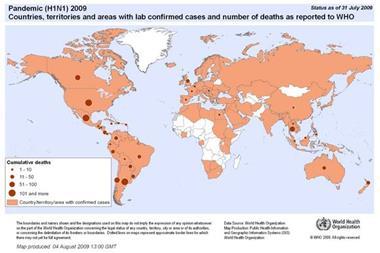Business continuity plans have been put to the test
Risk managers have been busy testing their pandemic preparedness plans as a new and potentially deadly strain of flu rapidly spread around the world.
The outbreak of influenza A (H1N1), or swine flu as it has been labelled, is believed to have started on a pig farm in Mexico. The disease regularly causes respiratory problems in pigs but the virus does not normally infect humans. What makes this outbreak rare, but not unique, is its rapid spread caused by human to human infection.
Within days of the virus being detected in Mexico the first cases were reported in the United States and Canada. The US Department of Health issued a nationwide public health emergency as the number of infections, particularly in New York schools, escalated. The first person to die of the disease outside of Mexico was an infant girl in Texas who had recently returned from a trip to Mexico. When the first evidence of human to human transmission emerged and the number of countries affected began to rise rapidly the World Health Organisation (WHO) raised its pandemic alert level to imminent. This was the signal for most countries and organisations to start implementing their pandemic preparedness plans.
Combined with the alarming speed at which the virus spread, another hallmark of the outbreak was the powerful sense of panic it instilled around the world. This was mainly the result of the media’s infatuation with the story. As many as ten countries reportedly banned the import of pork products despite continued reassurance and advice from the WHO that swine flu could not be transmitted by eating well cooked pork products. The media fanned the flames of panic by amplifying official public pronouncements of worst case scenarios. The new strain of flu is believed to be responsible for less than a hundred deaths worldwide, dramatically less than the average number of deaths attributable to the usual flu season.
As of 26 May, 46 countries had officially reported almost 13,000 cases of the new flu strain. Most victims suffer only mild flu symptoms. Nevertheless, the apparently mild affects should not encourage complacency. Even mild flu pandemics can bring extended staff absence both through direct illness and the closure of schools and child care facilities. The public perception of the risk is also crucial. Fearing the worst, many people may choose to avoid large public gatherings, which could impact some businesses more than others. In addition, although the disease has yet to prove characteristically deadly this could mean that there are several H1N1 strains and that the milder strain has the highest human to human transmissibility. A stronger, more deadly, strain of the flu could also reemerge later in the year. In a crisis meeting WHO director-general, Dr Margaret Chan insisted: ‘Influenza viruses are notorious for their rapid mutation and unpredictable behaviour.’
Further, developed Western economies could be most at risk to the spread of the disease, because of their high population density, urbanisation and busy airports. Outside of Mexico, the US, UK, Canada and Spain have proved to be the most susceptible to new cases. The Business Continuity Institute (BCI) suggested that Britain’s economy would be hit hard by major staff disruptions at a time of weakness caused by the recession. The situation could be made worse by the poor state of preparedness among UK organisations. Only a third of UK companies have a plan in place to cope with increased staff illness, reported the BCI. Organisations of all sizes are advised to put in place business continuity plans to fully prepare themselves for a pandemic, which could seriously affect staffing levels.
For those organisations that do not have a plan in place there are some essential steps that need to be considered, according to Lyndon Bird, director of the BCI. Companies should prioritise what processes are essential to keep their business running, he said, adding that some staff may need to work from home or from different office locations. ‘Companies should plan against absence levels of at least 25% and up to 50% for periods of between two and four weeks,’ he advised. Firms may also want to reduce the likelihood of infection for certain individuals with key skills by implementing travel restrictions or reducing human contact. Communication with staff and flexibility will be important because employees will be anxious and have their own problems, noted Bird. Risk managers may also want to review insurance policies to make sure they have cover for business interruptions. ‘If you are well prepared then you are more likely to be able to respond faster to the initial disruption, maintain a level of continuity and recover quicker back to normal business operations,’ added the BCI.
A survey of UK-based risk managers, including around 75% of FTSE 100 companies, conducted by AIRMIC, revealed a better level of preparedness from large organisations, but serious concerns were still evident. The main concerns in relation to a possible flu pandemic related to potential losses of staff and disruption to customer service. Asked to list their top two concerns, 54% said ‘loss of staff through illness’ and 46% said ‘inability to serve customers’. General economic disruption (26%), supply chain disruption (23%) and the risk of staff catching the virus from colleagues (22%) were the next biggest fears. As for plans to deal with these problems, more than three quarters (77%) of UK risk managers had set up a committee to review their current situation and nearly four fifths (79%) had appointed an individual to coordinate their pandemic plan.
Perhaps reflecting the size of their organisations, 76% of AIRMIC members said that they had a pandemic continuity plan in place. But only 30% had access to anti-viral medication for staff. About half of the sample had restricted overseas travel and a similar proportion were ready to implement a work from home policy if the situation deteriorated. Eighteen per cent said they had plans to restrict internal meetings. ‘Organisations should treat current events as a “dress rehearsal” and remain prepared,’ said AIRMIC chair and chief risk officer for DLA Piper, Julia Graham.



















